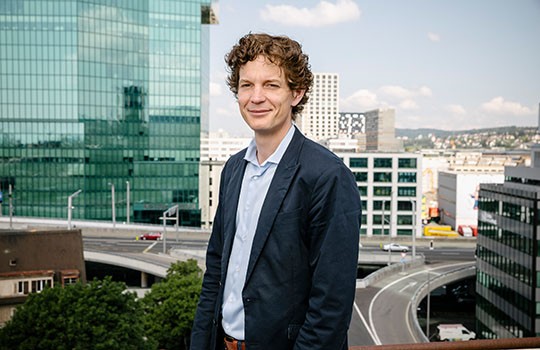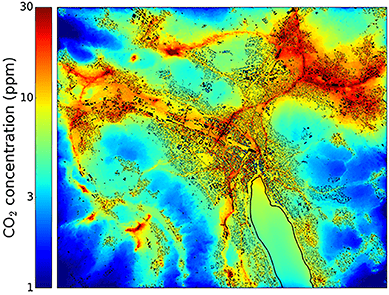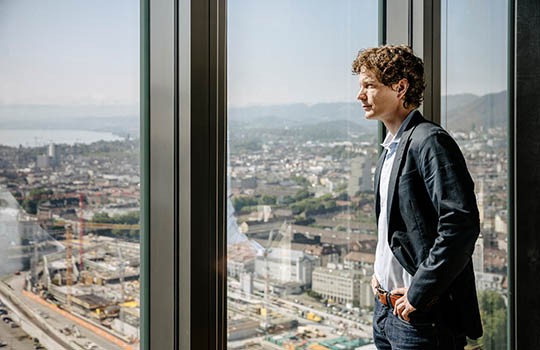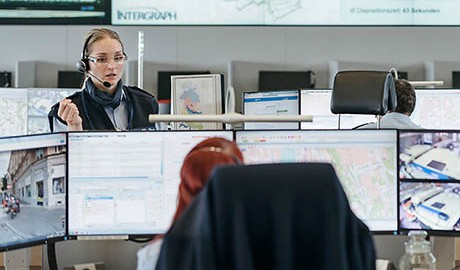Smart City
What smart cities can learn from bees
Everything is becoming smart thanks to the Internet of Things and new 5G mobile technology. But is high-tech really the way to make our cities smarter and organise future coexistence? Or should we draw inspiration from nature; for instance, from how bees co-exist? An interview with Stefan Metzger, Head of Smart City at Swisscom.
Text: Michael Lieberherr, Images: Bruno Augsburger, published in Swisscom Magazine on 9 July 2018
Stefan Metzger, what do bees and smart cities have in common?
Bees have perfected how they co-exist. They are careful with their resources and make the best use of their infrastructure. In many aspects, they are an ideal example for smart cities and communities. A honeycomb is the perfect example of how bees use their city. Every honeycomb is multifunctional; it can serve as a warehouse for nectar, a reservoir for honey or as a cradle.
What does that mean when adapted to smart cities?
The majority of a city’s infrastructure is poorly used. What’s wrong with using a clothes shop as a yoga studio in the evenings to make better use of the building? Why not use office buildings for advanced training in the evenings? According to Avenir Suisse, the average seat occupancy rate is only 30% in long-distance rail transport and a mere 20% in regional trains. Infrastructures are generally designed based on short-term peaks. For example, why do children go to school during commuter traffic?

Stefan Metzger, Head of Smart City at Swisscom.
They could go to school later in the day, but that would disrupt their extracurricular interests, such as sport, music and cultural activities.
Exactly. Instead, school children could start class at home online and then go to school after the rush hour is over. That would alleviate peak times. Or another example: we renovate building envelopes with complex development programmes, which makes sense in terms of saving energy. But what kind of energy balance would we have if we were to increase the occupancy rate of buildings from 40% to 80% with multifunctional use?
«What’s wrong with using a clothes shop as a yoga studio in the evening to make better use of the building?»
Stefan Metzger
So is efficiency the most important aspect of smart cities? What about our quality of life?
Don’t worry – it won’t fall by the wayside. Our cities need to become more resource-friendly and efficient to maintain a high quality of life. Switzerland has grown together to become an urban-like entity, even if that is something we do not like to hear. There is so much inefficiency in cities: for example, if online shopping continues to grow by even just a few percentage points, it will only be a matter of time before delivery traffic in the city collapses due to the increased number of trips. Smart cities should help solve these kinds of problems.
Smart cities should also improve how people live together and allow everyone to participate in social life. What is your opinion?
From a purely demographic point of view, an ageing population poses a great number of challenges. A fascinating answer is offered by the : help now – and receive help later. Technological change can also marginalise individuals. At the same time, technology helps to simplify daily tasks, assuming a knowledgeable approach. That is why the Swisscom Academy has been making an active contribution through the offer of smartphone classes.
There are already many initiatives that specifically support smart cities. What is still missing?
Many activities are isolated instead of being part of a bigger smart city concept. A lot is based on assumptions rather than facts. We first need to understand how a city or process functions in detail. For example, until just recently only a few CO2 sensors existed in Switzerland. Thanks to the Carbosense project, more than 300 sensors now operate throughout Switzerland and transmit data via the Swisscom Low Power Network.

CO concentration in Zurich. Source: EMPA
What results has Carbosense provided?
Measurements taken by the environmental sensors of the Carbosense project provide us with information; for example, where in Zurich the CO values exceed given thresholds and how the CO concentrations are distributed over the entire area. The assumption was that the impact of CO pollution from traffic, industry and heating was evenly distributed. But the model simulations paint an entirely different picture. CO concentration is highest along Hardbrücke, major traffic routes and at the airport. We calculate these kinds of models with high-tech, but the solution can be very low-tech: plant greenery on roofs and along traffic routes.
So is a city smart if it finds simple solutions using smart analytics?
It’s not possible to make such a broad statement. But many models suffer because they focus on the technology, which gives them a one-sided slant. Technology may be the solution, but not necessarily. At Swisscom, we have co-developed the Human Smart City model to identify holistic solutions.
Stefan Metzger
As Head of Smart City, Stefan Metzger has been responsible for the Smart City Programme at Swisscom since 1 March 2018. He previously served as head of the group-wide Smart City and IoT programme at Swiss Post. With his team, he built digital and physical bridges between cities, residents and the economy. Stefan Metzger holds a degree in mechanical and industrial engineering. He has a wealth of experience in research and development and innovation management both in the start-up scene and with large enterprises.
«Data is an essential factor in connecting different elements to create a smart city solution.»
Stefan Metzger
What do you mean by holistic?
Holistic means that things are connected to one another. It is easy to implement a smart parking solution, but is it a good solution if its data is not fed directly into a navigation system? If electronic payment is not an option? Data is an essential factor in connecting different elements to create a smart city solution. Bees use their role distribution and mode of communication to capture environmental parameters in order to be able to act in the interests of the entire bee colony.
So that means city residents should provide data?
Yes. For example, movement data from cyclists could help to identify the most important routes in order to expand the infrastructure in a targeted manner. In Montreux, we proved with our Insights Platform (analysis of anonymised movement data) that the proposed bypass tunnel would not relieve the traffic in the city centre as predicted. In the end, the city decided not to build the tunnel and saved millions.
How is this sort of movement data collected?
When mobile networks are used, movement profiles generated during operation are aggregated on an anonymous basis, so no conclusions can be drawn about specific individuals. Taken as a whole, the movement profiles provide clear information about traffic movements. For urban planners, this platform is like shifting from a photo to a film: for the first time, they are able to see traffic flows around the clock. In this case, high-tech is the foundation for low-tech solutions. A different route could solve many traffic problems without requiring too much technology.

Stefan Metzger: ‘Bees combine information for the benefit of the swarm. Smart cities need to link data in the same way.’
Data and citizens: is that not problematic? Will people be monitored in a smart city?
Every individual has the right to know who has saved their data and what it is being used for. Their personal data must be protected. The new European data protection regulation also confirms this. Of course, there are some examples in Asia that we, as Europeans, would consider equivalent to a surveillance state. But I am convinced that individuals in a democracy would provide their data in certain forms if they felt it added value to their daily lives.
Many smart city initiatives are based not on data, but on specific applications.
I believe that an evidence base must be established first. Some applications are much easier to sell in terms of PR, such as smart street lamps or intelligent waste bins. But they often develop in isolation and solve only part of the problem. The networking and clustering of different topics is essential. We have to identify connections visually, based on the available data.
What role do you envision for Swisscom in this context?
Thanks to our infrastructure and ICT expertise, we can make things visible to cities in order to give them a foundation for decision making. We are building on the ICT infrastructure to pool data-based facts in order to accomplish the objectives of a smart city.
How is Switzerland positioned in terms of smart cities?
Several cities are conducting pilot projects, but we have little to show compared with pioneering cities such as Nice, Helsinki and Darmstadt. It’s not necessary for every city to be in the same situation, but they should offer mutual support and organisation.
Smart cities and sustainability
Swisscom, as one of Europe’s most sustainable companies, is relying on concepts such as Smart City to achieve its six Corporate Responsibility goals by 2020.

Newsletter
Would you like to regularly receive interesting articles and whitepapers on current ICT topics?
More on the topic

